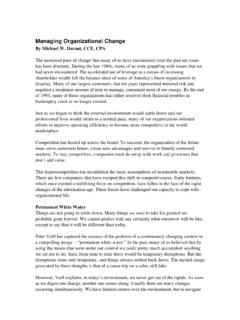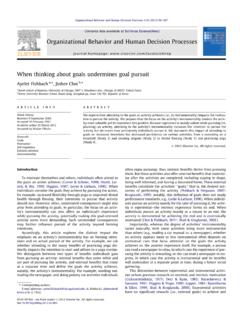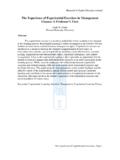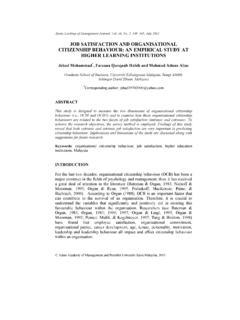Transcription of Managing Organizational Change
1 Managing Organizational ChangeBy Michael W. Durant, CCE, CPAThe increased pace of Change that many of us have encountered over the past ten yearshas been dramatic. During the late 1980s, many of us were grappling with issues that wehad never encountered. The accelerated use of leverage as a means of increasingshareholder wealth left the balance sheet of some of America s finest organizations indisarray. Many of our largest customers, that for years represented minimal risk andrequired a minimum amount of time to manage, consumed most of our energy.
2 By the endof 1993, many of these organizations had either resolved their financial troubles inbankruptcy court or no longer as we began to think the external environment would settle down and ourprofessional lives would return to a normal pace, many of our organizations initiatedefforts to improve operating efficiency to become more competitive in the has heated up across the board. To succeed, the organization of the futuremust serve customers better, create new advantages and survive in bitterly contestedmarkets. To stay competitive, companies must do away with work and processes thatdon t add hypercompetition has invalidated the basic assumptions of sustainable are few companies that have escaped this shift in competitiveness.
3 Entry barriers,which once exerted a stabilizing force on competition, have fallen in the face of the rapidchanges of the information age. These forces have challenged our capacity to cope withorganizational White WaterThings are not going to settle down. Many things we used to take for granted areprobably gone forever. We cannot predict with any certainty what tomorrow will be like,except to say that it will be different than Vaill has captured the essence of the problem of a continuously changing context ina compelling image - permanent white water.
4 In the past, many of us believed that byusing the means that were under our control we could pretty much accomplish anythingwe set out to do. Sure, from time to time there would be temporary disruptions. But thedisruptions were only temporary, and things always settled back down. The mental imagegenerated by these thoughts is that of a canoe trip on a calm, still , Vaill explains, in today s environment, we never get out of the rapids. As soonas we digest one Change , another one comes along. Usually there are many changesoccurring simultaneously.
5 We have limited control over the environment, but to navigatethe rapids we must exercise skill. The permanent white water image has a strong visualappeal, conveying as it does a sense of energy and providing a visual sense of navigatingon an unpredictable wild the VisionVision and leadership drive successful Change . As the Change agent, first you must create avision of the future that is capable of focusing the group s energy. The vision shouldcontrast what is with what can be and it must be comprehensive enough to directattention at how to bridge the gap to the must become a core Organizational value using customer feedback, internallydeveloped Organizational improvements and other external feedback.
6 Change initiativesshould also be linked to efforts to improve overall performance and from senior management at the earliest stages of the Change process isrequired. Managing Change effectively requires an understanding of the variables at play,and adequate time must be allowed for Stages of ChangeTo thrive in the chaotic world we live in, we must embrace strategies that have beendeveloped to successfully manage Change . The theory and practice of organizationalchange contains elements of both behaviorist and cognitive learning theories.
7 Aninvestigation into Change within an Organizational setting reveals a three-stage process ofunfreezing, Change and is the first stage of the Change process and consist of unlearning past Change process begins when the organization experiences is experienced in the form of cognitive dissonance. Cognitive dissonanceis a concept taken from the field of psychology that refers to incompatibility betweentwo or more attitudes or between behavior and attitudes. Inconsistencies from the desiredstate are uncomfortable and we try to reduce the dissonance and thus the may be caused by external pressures or convincing data from within theorganization.
8 An external example might occur due to pressure applied to seniormanagement by shareholders to increase the return on their investment. Dissonance maybe generated by internal benchmarking research that reveals areas in the organization thatrequire attention. If the factors creating the dissonance are relatively important thepressure to correct the imbalance will be a potential problem surfaces an information search begins to determine what actionis required to resolve the issue. If a problem exists, creative solutions are for unlearning develops when existing systems are challenged.
9 Unfreezinginvolves dismantling past second stage of the Change process consist of incorporating new behaviors intoorganizational processes. behavior and ideas that are embedded in the corporate culturemust be replaced. Redirecting people s attention is an essential part of Change . Thedevelopment of skills to enable people to do things differently is required. Training mustbe provided to insure that employees understand their roles in making Change and people must be aligned to support Change . Skills and competencies toenable people to do things differently must be developed.
10 Employees must understandthe dynamics of the Change process and also the functional requirements of the rules and policies that reinforce the desired ways of operating must be created anddocumented. Old customs and norms that reinforce the old ways of doing things must bereplaced with norms that reinforce the new ways. For example, if the organization isdeveloping teams and moving away from functional departments, then team work acrossdepartmental boundaries should be emphasized. Rewards should be specific to the changegoals that have been is the final stage of the Change process.










